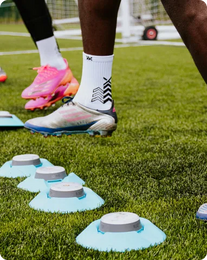For millions of football fans around the globe, the cycle of excitement moves from the Super Bowl to the NFL Scouting Combine, the OTAs and the NFL Training Camp- in that order.
Essentially, NFL Training Camps and OTAs are offseason practices and drills meant to recharge everyone before the following season. These events are just as important to the fans and the media as to the coaches and players.
OTAs are organized team practice activities that take place in the third phase of each club’s 9-week offseason workout program. The clubs’ workout program is defined under Article 21 of the NFL-NFLPA Collective Bargaining Agreement of 2011. This CBA makes OTA football activities purely voluntary, meaning that players cannot be fined for failing to attend them.
Generally, football OTA activities consist of meetings, drills and studying of films. Teams can conduct practice for six hours maximum but cannot keep players on the field for more than two hours.
On the other hand, the NFL Training Camp refers to an intense series of workouts during the weeks leading to the preseason. While OTA football events don’t involve live contacts, NFL athletic training is when coaches ease their players into the team’s playbooks. One-on-one and small team drills are allowed in order to see players compete against each other. This gives the team management an idea of who will make the active roster for the upcoming season.
Do NFL players get paid for training camp? Yes, unlike OTAs, players are paid for attending the NFL Training Camp. But these camps are compulsory, too, and players can be fined up to $50,000 per day for an unexcused absence.
What, When and How do the OTAs Work?
What does OTA mean? OTAs is an acronym for Organized Team Activities. Up until 2011, not many football fans knew about OTAs. Its importance was popularized by signing the Collective Bargaining Agreement between the NFL and the NFL Players Association (NFLPA) in 2011.
Article 21 of the 2011 CBA defines each club’s official, voluntary 9-week offseason workout program and what it should entail. This workout program starts in April and ends around June and is conducted in three phases:
- Phase 1- covered in the first two weeks of the program and is limited to strength and conditioning activities and rehabilitation. No other coaches apart from full-time and part-time strength and conditioning coaches are allowed on the field. Also, footballs and helmets are not permitted in this phase.
- Phase 2- typically, this phase takes place over the next three weeks of the offseason workout program. All coaches are allowed on the field. Workouts may comprise individual player practice and team drills so long as it’s perfect play, for instance, offense or defense only. Live contact and team vs. team drills are not permitted.
- Phase 3- this stage covers the next four weeks of the workout program. During the four weeks, usually around May, the club is allowed to conduct a total of ten days of Organized Team Activities (OTAs). The team is allowed to have a maximum of three OTAs in each of the first two weeks of phase three. The last four days of football OTAs are conducted either during the third or fourth week.
What Does an OTA in Football Involve?
The OTAs usually take place in May of each year. They consist of meetings, drills and film study. These activities are spread across a maximum of six hours per OTA day, of which the players are not supposed to exceed two hours on the field.
All coaches are allowed on the field during football OTAs, but live contact is prohibited. The clubs cannot conduct workouts, such as one-on-one offense vs. defense workouts or wide receivers vs. defensive backs. However, special teams drills are allowed so long as there’s no live contact. Lastly, OTAs are voluntary, and players may be required to wear helmets. Shells are not permitted, however.
What, When and How do NFL Training Camps Work?
The NFL Training Camp refers to a time of thorough workout activities that lead to a regular season. The NFL-NFLPA deems the NFL Athletic Training as the entire period from the start of the camp to the last weekend before the season begins in a given league year.
These training camps offer new players an opportunity to meet new teammates and acclimate themselves to the systems. But for veterans, this is a time to get back into shape.
Unlike football OTA, NFL Training Camps are mandatory for all players. There are hefty fines for players who don’t show up. The new 2020 NFL-NFLPA CBA increased the penalty fees for skipping NFL Training Camp from $40,000 to $50,000 per day except for rookies who are yet to enter their fifth-year option season.
On the other hand, NFL players are paid for attending preseason training camps on a “per diem” basis. How much each NFL player pockets depends on whether he is a veteran or a rookie. For 2021-22 League Years, the weekly rate for first-year players is $1700, while veterans take almost twice as much at $2900.
On the same note, the clubs reimburse reasonable travel expenses to all contracted players. Each of the clubs also provides room and board for players who don’t come from the same location as the NFL training camp is taking place.
When Does NFL Training Camp Start?
NFL Training Camps start between mid-July and early August. There are lots of variables affecting the actual starting date, as pointed out in the 2020 CBA. For instance, if a club’s first regular game for the season is scheduled on a Thursday or Sunday, all veteran players except quarterbacks and injured players are expected to report to the training camp 47 days earlier.
If the starting game is on a Monday, veteran players, excluding quarterbacks and injured players, must arrive 48 days earlier. Additionally, the CBA prohibits rookies and first-year players from arriving at the team’s training camp earlier than seven days before the mandatory arrival date for that team’s veteran players.
Here’s What Happens During NFL Athletics Training Camp
NFL Athletes Training Camps are commonly divided into two segments: a five-day on-field acclimation period and two-a-day practices.
The first day of the five-day acclimation involves meetings, medical examinations and classroom instructions. Clubs may take their teams through proper running and conditioning drills, but other types of on-field activities are not permitted.
From day two to five, clubs may undertake on-field activities provided there’s no live contact. Again, clubs may not keep players in the field for more than 3.5 hours. On-field practices usually involve two sessions. One session may be a full-speed practice, which necessitates the use of helmets. However, such a drill can only go for two hours maximum, in which case the second session has to be a walk-through instruction or drill not exceeding 1.5 hours.
After the 5-day acclimation period, players enter the two-a-day phase. This phase permits clubs to keep the players on the field for no longer than four hours per day. The 4 hours are divided between one padded on-field practice, which can’t be longer than 2.5 hours and a walk-through instruction session or play for the remaining on-field time. Helmets are not allowed during the second activity.
After the acclimation period, a typical day at the training camp involves getting treatment, training in NFL weights, practices, reviewing tapes, and resting.
Types of Exercises and Drills in These Events
7-on-7 Drill
This drill sets up the defense and offense players as they would on game day, except for linemen. By letting the players compete in a series of pass plays, this OTA drill helps develop and perfect passing concepts, techniques and strategies. This passing game also allows the coach to make points between repetitions to help all players understand their roles and responsibilities for different play calls.
9-on-7 Drill
The 9-on-7 is another popular drill in football OTAs. This system has been nicknamed the “Beat Ohio Drill” after Michigan head coach Jim Harbaugh used it to win against the Wolverines in unlikely circumstances in 2020. Jim Harbaugh says that the 9-on-7 drill packs three types of running plays allowing the players to unleash one or two defensive strategies.
One-on-One Pass Rush
The one-on-one pass rush is among the most popular NFL Training Camps drills. It’s physical and nasty and challenges football players to give their all in speed, footwork and countermoves, among other strengths. Part of what makes this drill so fascinating is that it puts both teams under the spotlight.
Squat ‘Til You Drop
Coaches and pro athletes understand that success in football comes down to three things: strength, stability, and balance. Squats are among the best exercises for improving these attributes. That’s why this workout is a staple in most NFL Training Camps.
Conclusion
OTAs(Organized Team Activities) offer coaches the first chance to build a winning team for the upcoming season. This is the perfect time for fringe players and rookies to showcase their ability and make a quick impression. No one attracts a coach’s attention better than a physically fit, flexible and robust player with football-specific conditioning. For such events Blazepod provides coaches, trainers and athletes a versatile, light-based system with tons of preloaded drills to offer sport-specific training ideas. Click here to learn more.
FAQs
What does OTA stand for in football?
OTA stands for Organized Team Activities. These are voluntary workout activities during phase three of the club’s 9-week official offseason workout program. NFL Football OTAs occur in three phases between April and June.
What do you do at football OTAs?
NFL OTAs mainly consist of in-person or virtual meetings, drills and studying of films. All coaches are allowed on the field, and team and special exercises are permitted, provided there’s no live contact. Clubs may require players to wear helmets, elbow and knee pads and any other necessary braces. But shoulder pads are not allowed.
Do players get paid for OTAs?
No. Unlike Training Camp NFL, players are not paid for attending OTA Football practices. However, most clubs have workout bonuses attached to the player’s contracts to encourage attendance. Most teams that offer incentives require an NFL player to attend a predetermined number of OTAs to receive the workout bonus.
What happens at OTAs?
Players undergo a series of in-person or virtual meetings as well as classroom instructions and on-field drills to prepare them during the offseason.
How long are football OTAs?
OTAs are ten days long spread across the four weeks of phase three of the voluntary offseason workout program. According to the NFL-NFLPA 2011 CBA, clubs should have three OTAs days during the first two weeks of phase three and the last four days in week three or four. NFL OTA practices last a maximum of 6 hours a day, and players may not be kept in the field for more than 2 hours.
When does the NFL training camp start?
Players start reporting for the NFL Training Camp from mid-July to around the 27th of the same month. Rookies almost always arrive around seven days before the veterans.





















